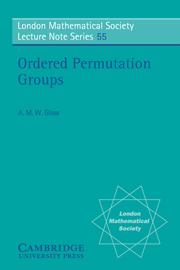Book contents
- Frontmatter
- Contents
- PREFACE
- Background Terms and Notation
- Explanation of Diagrams
- PART I OPENING THE INNINGS
- PART II THE STRUCTURE THEORY
- PART III APPLICATIONS TO ORDERED PERMUTATION GROUPS
- PART IV APPLICATIONS TO LATTICE-ORDERED GROUPS
- PART V THE AUTHOR'S PREROGATIVE
- APPENDIX I
- APPENDIX II
- SOME UNSOLVED PROBLEMS
- BIBLIOGRAPHY
- ANNOTATIONS
- INDEX
- INDEX OF SYMBOLS
PREFACE
Published online by Cambridge University Press: 04 August 2010
- Frontmatter
- Contents
- PREFACE
- Background Terms and Notation
- Explanation of Diagrams
- PART I OPENING THE INNINGS
- PART II THE STRUCTURE THEORY
- PART III APPLICATIONS TO ORDERED PERMUTATION GROUPS
- PART IV APPLICATIONS TO LATTICE-ORDERED GROUPS
- PART V THE AUTHOR'S PREROGATIVE
- APPENDIX I
- APPENDIX II
- SOME UNSOLVED PROBLEMS
- BIBLIOGRAPHY
- ANNOTATIONS
- INDEX
- INDEX OF SYMBOLS
Summary
In the past thirty years, groups of order-preserving permutations of totally ordered sets have been extensively studied. The purpose of these notes is to provide a uniform, systematic account of this research and its applications. In the first half of this book (Parts I and II), I attempt a streamlined (and I trust intuitive) presentation of the main results in the structure theory, taking full advantage of recent research. In Chapters 3 and 5, the study of such permutation groups is reduced to an investigation of the basic building blocks of the subject, “primitive” order-preserving permutation groups. These are classified and examined in Chapters 2 and 4. The second half of the book is devoted to various applications of the structure theory; e.g., to the construction of infinite simple groups. Most of the chapters in it can be read quite independently of each other. I have chosen the topics to illustrate the use of the structure theory in a wide variety of settings, but readily admit that the selection is strongly influenced by my own quirks and prejudices. The total order on a set naturally lifts to a lattice order on its group of order-preserving permutations. Since every lattice-ordered group can be embedded (as a group and lattice simultaneously) in such a lattice-ordered group–the Cayley-Holland Theorem, see Appendix I–the theory can be used to study lattice-ordered groups.
- Type
- Chapter
- Information
- Ordered Permutation Groups , pp. viii - xPublisher: Cambridge University PressPrint publication year: 1982



